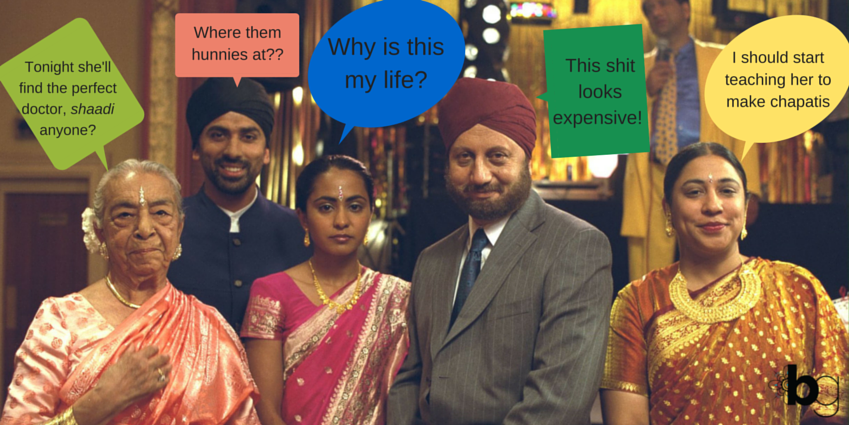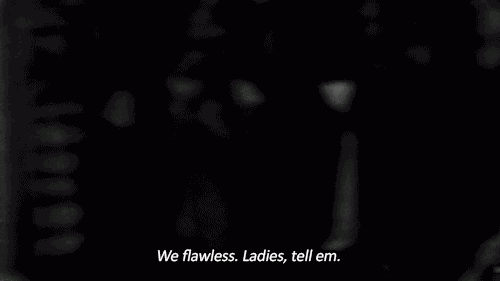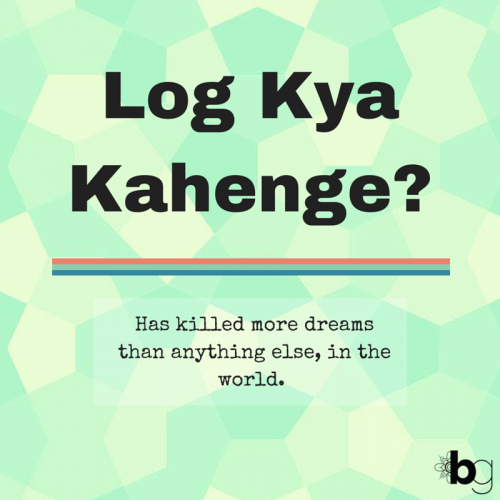
by Nidhi Singh – Follow @nidhisingh
Dear Aunty,
Imagine this:
You’re at a wedding trying to scope out the “potentials.” I mean, there’s the doctor eating chicken kabobs but then there’s also the businessman eating gulab jamun. So, which should you go for?
Gulab jamun it is.
But where are they? Is that Nikki eating a plate full? Maybe I’ll just run over and steal one from her.
Oh wait, is that aunty next to her? Abort Operation G.J. and avoid aunty at all costs. No, don’t make eye contact. Crap, I made eye contact. No, don’t come in this direction…
“…Oh hi Auntie!”
“Hi beta! You look beautiful! Are you next in line? If you are, maybe you should learn how to cook too!”
“Uh well, I make a pretty killer peanut butter jelly sandwich!”
“That’s okay, beta. I’m sure you know so many religious hymns!”
“Yes! In fact, I take pride in knowing all the words to Beyonce’s ‘Flawless.’”
 [Photo Source/Tumblr]
[Photo Source/Tumblr]
Wait a sec.
Before you ask me where I work and indirectly insult me for studying journalism in college, I think it’s best we pause this conversation.
Aunty, I think I know what’s going on here: It’s wedding season.
Besides the excitement of celebrating the new couple, the endless supply of laddoos and the joy of finding the open bar (yes, I drink), there is something else that secretly looms behind the celebrations: matchmaking.
Weddings are every parent’s matchmaking dream—am I right or am I right?
Now, don’t get me wrong. Some people are more than happy to find a suitor at a wedding. On the other hand, there are people like me, who are really trying to find out where little Nikki found the gulab jamun.
But let’s be real, I don’t want to find a suitor right now. There—I said it! Maybe I’ll keep my eyes open but I honestly have no intention of getting married in the near future.
Shocked? Meh, you’ll eventually get over it. But only after you say things like:
“Log kya kahenge?! Everyone is getting married. It’s time you did too. You need a husband.”

First things first, I’m only 23. Extra emphasis on the number—should I make it bold? 23.
Unless you can count fantasizing about my own Euro-rail adventure with a Raj Malhotra, I haven’t thought about getting hitched.
And second, why do I NEED a husband?
You pushing me to “hurry up and find a husband” is sending me a completely different message.
For one, you make it sound like the sole purpose of every desi girl’s life is to get married. Until I am betrothed, the life I’ve led up to now is purely insignificant?
Okay, so, maybe that’s not what you’re getting at, BUT that’s exactly how you’re making me feel.
Because I love Bollywood, I feel the need to quote the wonderfully talented Rani Mukerji.
Yes, the glitzy world of Bollywood can provide for some unrealistic expectations but this famed bathroom scene from Hum Tum, really spoke to me:
“Mujhe ek baat samajh mein nahi aati ki jab tak ek ladki ki shaadi nahi hoti, logon ko chain kyun nahi aata? Kya hamari zindagi ka maksat sirf shaadi karna hai? Jab tak ek aurat ki zindagi mein ek aadmi nahi, uski zindagi safal nahi ho sakti?”
 AMEN, SISTER
AMEN, SISTER
Why? Why does our culture, in this present day and age, find it necessary to push young women and men to rush into marriage?
Maybe because as we get older, we are no longer in our “prime.” Or we’ll be too old to bear children? Because who knows what friends and family will think? Because Pinky and Rohan’s shaadi has been fixed and I’m still single? Come on, now!
Even if I was older than 30, 40, etc., why is it so important to you that I must hurry and “settle down?”
I know you just want the best for me and my life.
Trust me, I’ll get married and I’ll find a husband when the time is right. However, I just want to focus on my life right now.
I want to build my career. I want to become the person I’ve always dreamed of being. I have goals to achieve and the whole world to see.
Moreover, I’d like to avoid being an emotional wreck as a married woman. Marriage is a two-way street. How am I supposed to be there for someone else when I’m currently trying to figure out how to be there for myself?
I promise that’s not selfish. Everyone does it! Ask your son.
This is in no way an act of disrespect toward those who have decided to tie the knot at an early age or to tie the knot at all. In fact, it’s very exciting for couples to make this decision and I’m genuinely happy for them! For some, the time is right. We are all different and timing is distinct to each of us.
I know, I know, when you were my age, you were already married and probably had a few kids. I applaud your strength as a parent and in general as a human being. You really are a superhero.
And to those of you who are tying the knot this year and in the coming years: a heartfelt congrats are in order!
Also, can you please direct me to the gulab jamun? I’ve lost track of little Nikki.
Love,
Nids
Nidhi Singh is a recent graduate from UNC-Chapel Hill with a degree in journalism and is taking this time to explore the world through photography, film, and words. She enjoys dancing, travelling, eating Nutella, and watching reruns of old “Friends” episodes (as should anyone!). Follow Nidhi on Twitter and Instagram to see where she takes her next selfeet.




